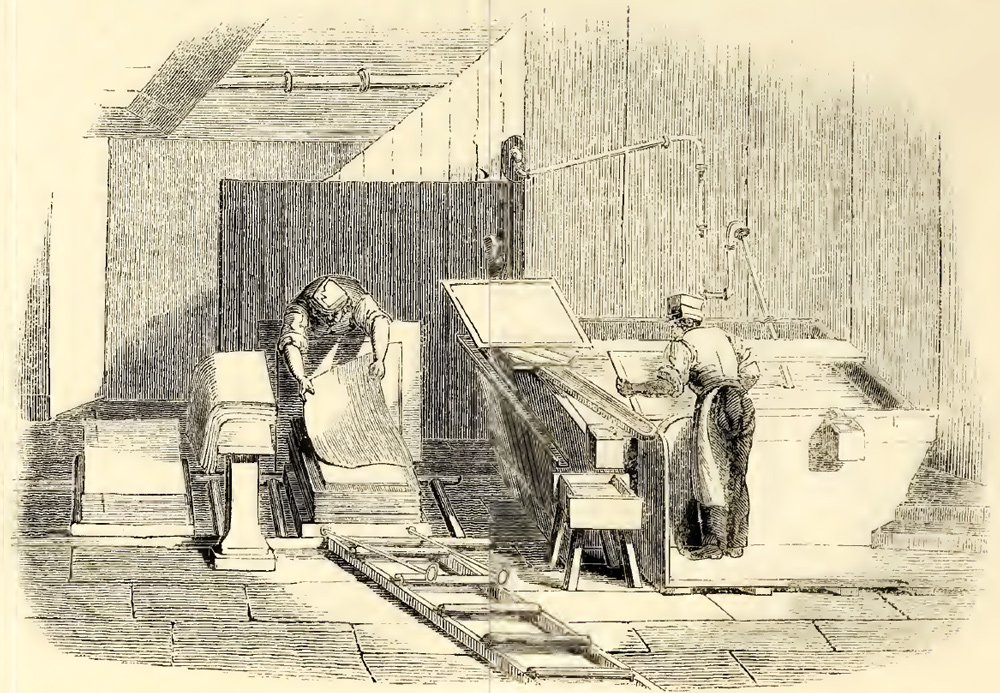Meriwether Lewis waits in Pittsburgh for the barge to be built prior to departure down the Ohio River. Here, manufacturing and ship building on the Monongahela River is described by François André Michaux, and paper making is explained.
Making Paper
The Pictorial Gallery of Arts, Figure 1417[1]From Robert M. Palmer, The Pictorial Gallery of Arts (London: Charles Knight and Co., 1905), page 349, downloaded from historicpittsburgh.org/islandora/object/pitt%3A31735060444753.
Of all the little towns built upon the Monongahela, New Geneva and Redstone have the most active commerce. The former has a glass-house in it, the produce of which is exported chiefly into the western country; the latter has shoe and paper manufactories, several flour mills, and contains about five hundred inhabitants. At this town a great number of those who emigrate from the eastern states embark to go into the west. It is also famous for building large boats, called Kentucky boats: used in the Kentucky trade; numbers are also built at Elizabeth Town, situated on the same river, about twenty-three miles from Pittsburgh—the Monongahela Farmer was launched there, a sailing vessel of two hundred tons.
—François André Michaux[2]François André Michaux, Travels to the West of the Alleghany Mountains (1805 reprint from London edition), p. 66 in Reuben G. Thwaites, Travels West of the Alleghanies, (Cleveland: The Arthur H. … Continue reading
Paper Making
For the accompanying figure, the Pictorial Gallery of Arts gives this description of making paper:
There are three stages in the manufacture of paper from cotton or linen rags—the conversion of the rags into a pulp, the formation of a thin layer or stratum from this pulp, and the drying of the layer into the form of a sheet of paper . . . .
Two men work together at the paper-making processes—one called the “vatman,” and the other the “coucher;” and they are provided with the apparatus seen in Fig. 1417. The vatman makes use of two moulds, which are slight frames of wood covered with fine wire, and fitting to each mould is a “deckel,” or raised edge, whose position determines the size of the sheet of paper to be made. . . . Thus the two workmen proceed; the one collecting thin layers of pulp from the vat, and the other interleaving these layers with pieces of flannel. It must be obvious that these operations require great care, especially on the part of the vatman, since he has to determine the quantity of pulp taken . . . .
When six or eight quires of paper are thus made, the heap, with the flannels between the layers, is subjected to great pressure. After this the heap is opened, and all the sheets are found to be sufficiently coherent to hold together without the aid of the felts; the latter are removed, and the sheets of paper, being placed upon another, are moderately pressed. The sheets are next parted, dried, sized, dried again, pressed, examined, and finally made up into quires.[3]Palmer, The Pictorial Gallery of Arts, 342, 343.
Found among the journals sent from Fort Mandan to Washington City in “Recapitulation of Seven Bales & 1 Box of necessy Stores Vit. [viz.]” are listed quires of foolscap paper and half quires of post paper.[4]Moulton, Journals, 3:503,504. A quire was a package of twenty-four or twenty-five papers of the same dimensions and quality. A sheet of post paper when folded into eight leaves makes sixteen pages—an octavio—that matches the size of the pages in William Clark‘s elkskin journal.[5]Katherine S. Kelly, “The Elkskin Journal: A Description of the Binding and Instructions for Making a Replica,” We Proceeded On, Vol. 48 No. 3, August 2022, p. 32–44.
Notes
| ↑1 | From Robert M. Palmer, The Pictorial Gallery of Arts (London: Charles Knight and Co., 1905), page 349, downloaded from historicpittsburgh.org/islandora/object/pitt%3A31735060444753. |
|---|---|
| ↑2 | François André Michaux, Travels to the West of the Alleghany Mountains (1805 reprint from London edition), p. 66 in Reuben G. Thwaites, Travels West of the Alleghanies, (Cleveland: The Arthur H. Clark Co., 1904), p. 162. |
| ↑3 | Palmer, The Pictorial Gallery of Arts, 342, 343. |
| ↑4 | Moulton, Journals, 3:503,504. |
| ↑5 | Katherine S. Kelly, “The Elkskin Journal: A Description of the Binding and Instructions for Making a Replica,” We Proceeded On, Vol. 48 No. 3, August 2022, p. 32–44. |

